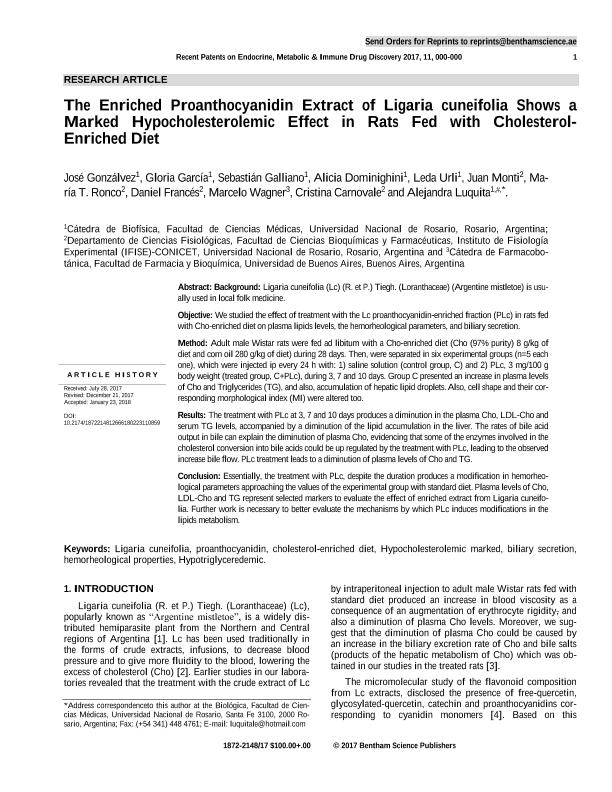Artículo
The enriched proanthocyanidin extract of Ligaria cuneifolia shows a marked hypocholesterolemic effect in rats fed with cholesterol-enriched diet
Gonzálvez, José Enrique; García, Gloria Angélica; Galliano, Sebastián Ariel; Dominighini, Alicia; Urli, Leda Diana; Monti, Juan Alberto; Ronco, Maria Teresa ; Frances, Daniel Eleazar Antonio
; Frances, Daniel Eleazar Antonio ; Wagner, Marcelo; Carnovale, Cristina Ester
; Wagner, Marcelo; Carnovale, Cristina Ester ; Luquita, Alejandra Nora
; Luquita, Alejandra Nora
 ; Frances, Daniel Eleazar Antonio
; Frances, Daniel Eleazar Antonio ; Wagner, Marcelo; Carnovale, Cristina Ester
; Wagner, Marcelo; Carnovale, Cristina Ester ; Luquita, Alejandra Nora
; Luquita, Alejandra Nora
Fecha de publicación:
02/2018
Editorial:
Bentham Science Publishers
Revista:
Recent Patents on Endocrine, Metabolic and Immune Drug Discovery
ISSN:
2212-3334
Idioma:
Inglés
Tipo de recurso:
Artículo publicado
Clasificación temática:
Resumen
Background: Ligaria cuneifolia (Lc) (R. et P.) Tiegh. (Loranthaceae) (Argentine mistletoe) is usually used in local folk medicine. Objective: We studied the effect of treatment with the Lc proanthocyanidin-enriched fraction (PLc) in rats fed with Cho-enriched diet on plasma lipids levels, the hemorheological parameters, and biliary secretion. Method: Adult male Wistar rats were fed ad libitum with a Cho-enriched diet (Cho (97% purity) 8 g/kg of diet and corn oil 280 g/kg of diet) during 28 days. Then, were separated in six experimental groups (n=5 each one), which were injected ip every 24 h with: 1) saline solution (control group, C) and 2) PLc, 3 mg/100 g body weight (treated group, C+PLc), during 3, 7 and 10 days. Group C presented an increase in plasma levels of Cho and Triglycerides (TG), and also, accumulation of hepatic lipid droplets. Also, cell shape and their corresponding morphological index (MI) were altered too. Results: The treatment with PLc at 3, 7 and 10 days produces a diminution in the plasma Cho, LDL-Cho and serum TG levels, accompanied by a diminution of the lipid accumulation in the liver. The rates of bile acid output in bile can explain the diminution of plasma Cho, evidencing that some of the enzymes involved in the cholesterol conversion into bile acids could be up regulated by the treatment with PLc, leading to the observed increase bile flow. PLc treatment leads to a diminution of plasma levels of Cho and TG. Conclusion: Essentially, the treatment with PLc, despite the duration produces a modification in hemorheological parameters approaching the values of the experimental group with standard diet. Plasma levels of Cho, LDL-Cho and TG represent selected markers to evaluate the effect of enriched extract from Ligaria cuneifolia. Further work is necessary to better evaluate the mechanisms by which PLc induces modifications in the lipids metabolism.
Archivos asociados
Licencia
Identificadores
Colecciones
Articulos(IFISE)
Articulos de INST.DE FISIOLOGIA EXPERIMENTAL (I)
Articulos de INST.DE FISIOLOGIA EXPERIMENTAL (I)
Citación
Gonzálvez, José Enrique; García, Gloria Angélica; Galliano, Sebastián Ariel; Dominighini, Alicia; Urli, Leda Diana; et al.; The enriched proanthocyanidin extract of Ligaria cuneifolia shows a marked hypocholesterolemic effect in rats fed with cholesterol-enriched diet; Bentham Science Publishers; Recent Patents on Endocrine, Metabolic and Immune Drug Discovery; 11; 1; 2-2018; 47-53
Compartir
Altmétricas



